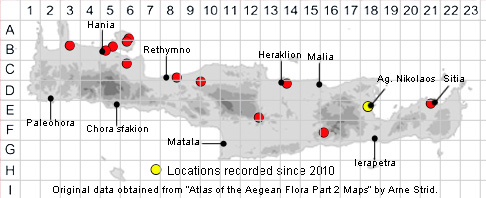
SPECIES DESCRIPTION
CYMBALARIA MURALIS
Family and Genus:- See- PLANTAGINACEAE
Common Names:- Ivy-leaved toadflax
Homotypic Synonyms:- Linaria cymbalaria
Meaning:- Cymbalaria (L) Cymbal-like (reference to the leaves).
Muralis (L) Of walls, growing on walls.
General description:- Trailing, often purplish, tufted, hairless perennial, except
sometimes for a few hairs on young leaves and stems.
Stems:-
1) Up to 60 cm; middle and upper internodes about equal.
Leaves:-
1) Alternate, simple, rounded to reniform, with 5 to 9 lobes, green above and a little
purplish below, from 10-15 mm across, fleshy, glabrous, with a long petiole.
a) nervation palmate.
Flowers:-
1) Bilaterally symmetrical, violet purple, lilaceous, seldom white, with yellow marks,
from 7-15 mm length, solitary at the axil of the leaves,
2) Pedicels, filiform.
3) Corolla, with 2 lips:
a) lower, 3-lobed.
4) Calyx, with 5 more or less unequal, glabrour sepals, with narrow and acute teeth.
5) Spur, from 1,5-3 mm in length.
6) Stamens, 4, unequal.
Fruit:-
1) Capsule, c. 4 mm, glabrous, considerably exceeding the calyx.
2) Seeds, c.1 mm, broadly ellipsoid to globose, black, ornamented with high, acute
ridges and usually a few tubercles. a
Key features:-
1) Petiole and leaves, glabrous at maturity.
2) Corolla, not more than 15 mm.
3) Middle and upper internodes, usually about equal.
4) Spur, 1·5-3 mm, about as long as calyx.
5) Capsule, glabrous.
6) Seeds, remaining separate; rugose or alveolate.
7) Most of the leaves 5- to 9-lobed.
Habitat:- Usually on walls in towns and villages, often on churches, occasionally
semi-natural habitats in gorges. 0-600 m.
Distribution:- S and W Balkans, Aegean Is., Crete; widely naturalised in parts of
the Med, especially Europe. Somewhat limited distribution on Crete, but probably
under recorded.
Flowering time:- Mainly Apr-June.
Photos by:- Steve Lenton
